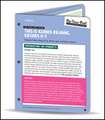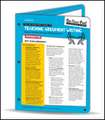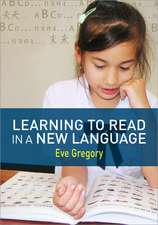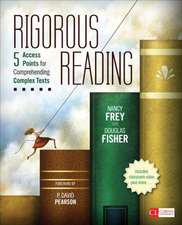Fun-Size Academic Writing for Serious Learning: 101 Lessons & Mentor Texts--Narrative, Opinion/Argument, & Informative/Explanatory, Grades 4-9: Corwin Literacy
Autor Gretchen S. Bernabei, Judith A. Reimeren Limba Engleză Paperback – 2 sep 2013
Din seria Corwin Literacy
-
 Preț: 285.18 lei
Preț: 285.18 lei -
 Preț: 158.08 lei
Preț: 158.08 lei -
 Preț: 278.39 lei
Preț: 278.39 lei -
 Preț: 243.82 lei
Preț: 243.82 lei -
 Preț: 244.25 lei
Preț: 244.25 lei -
 Preț: 88.42 lei
Preț: 88.42 lei -
 Preț: 273.64 lei
Preț: 273.64 lei -
 Preț: 274.70 lei
Preț: 274.70 lei -
 Preț: 200.91 lei
Preț: 200.91 lei -
 Preț: 248.26 lei
Preț: 248.26 lei -
 Preț: 284.26 lei
Preț: 284.26 lei -
 Preț: 294.79 lei
Preț: 294.79 lei -
 Preț: 281.36 lei
Preț: 281.36 lei -
![Mindsets and Moves: Strategies That Help Readers Take Charge [Grades K-8]](https://i3.books-express.ro/bs/9781506314938/mindsets-and-moves.jpg) Preț: 156.17 lei
Preț: 156.17 lei -
 Preț: 283.27 lei
Preț: 283.27 lei -
 Preț: 88.42 lei
Preț: 88.42 lei -
 Preț: 281.94 lei
Preț: 281.94 lei -
 Preț: 248.26 lei
Preț: 248.26 lei -
 Preț: 278.64 lei
Preț: 278.64 lei -
 Preț: 267.50 lei
Preț: 267.50 lei -
 Preț: 237.15 lei
Preț: 237.15 lei -
 Preț: 270.76 lei
Preț: 270.76 lei -
![Comprehension [Grades K-12]: The Skill, Will, and Thrill of Reading](https://i3.books-express.ro/bs/9781071812839/comprehension-grades-k-12.jpg) Preț: 287.79 lei
Preț: 287.79 lei -
 Preț: 278.10 lei
Preț: 278.10 lei -
 Preț: 245.45 lei
Preț: 245.45 lei -
 Preț: 204.26 lei
Preț: 204.26 lei -
 Preț: 272.62 lei
Preț: 272.62 lei -
![Every Minute Matters [Grades K-5]: 40+ Activities for Literacy-Rich Classroom Transitions](https://i4.books-express.ro/bs/9781544382449/every-minute-matters-grades-k-5.jpg) Preț: 193.61 lei
Preț: 193.61 lei -
 Preț: 274.00 lei
Preț: 274.00 lei -
![Flash Feedback [Grades 6-12]: Responding to Student Writing Better and Faster – Without Burning Out](https://i4.books-express.ro/bs/9781544360492/flash-feedback-grades-6-12.jpg) Preț: 232.71 lei
Preț: 232.71 lei -
 Preț: 88.67 lei
Preț: 88.67 lei -
 Preț: 147.92 lei
Preț: 147.92 lei -
 Preț: 273.44 lei
Preț: 273.44 lei -
 Preț: 184.56 lei
Preț: 184.56 lei -
 Preț: 88.67 lei
Preț: 88.67 lei -
 Preț: 236.11 lei
Preț: 236.11 lei -
 Preț: 209.15 lei
Preț: 209.15 lei -
 Preț: 256.83 lei
Preț: 256.83 lei -
 Preț: 291.04 lei
Preț: 291.04 lei -
 Preț: 288.67 lei
Preț: 288.67 lei -
 Preț: 273.44 lei
Preț: 273.44 lei -
 Preț: 278.10 lei
Preț: 278.10 lei -
 Preț: 174.52 lei
Preț: 174.52 lei -
 Preț: 244.44 lei
Preț: 244.44 lei -
![Mentor Texts That Multitask [Grades K-8]: A Less-Is-More Approach to Integrated Literacy Instruction](https://i3.books-express.ro/bs/9781071836132/mentor-texts-that-multitask-grades-k-8.jpg) Preț: 241.23 lei
Preț: 241.23 lei -
 Preț: 140.61 lei
Preț: 140.61 lei -
 Preț: 216.22 lei
Preț: 216.22 lei -
 Preț: 218.84 lei
Preț: 218.84 lei -
 Preț: 273.44 lei
Preț: 273.44 lei
Preț: 277.50 lei
Nou
Puncte Express: 416
Preț estimativ în valută:
53.10€ • 55.59$ • 43.94£
53.10€ • 55.59$ • 43.94£
Carte disponibilă
Livrare economică 15-29 martie
Preluare comenzi: 021 569.72.76
Specificații
ISBN-13: 9781452268613
ISBN-10: 1452268614
Pagini: 264
Ilustrații: Illustrations
Dimensiuni: 216 x 279 x 17 mm
Greutate: 0.64 kg
Ediția:1
Editura: SAGE Publications
Colecția Corwin
Seria Corwin Literacy
Locul publicării:Thousand Oaks, United States
ISBN-10: 1452268614
Pagini: 264
Ilustrații: Illustrations
Dimensiuni: 216 x 279 x 17 mm
Greutate: 0.64 kg
Ediția:1
Editura: SAGE Publications
Colecția Corwin
Seria Corwin Literacy
Locul publicării:Thousand Oaks, United States
Recenzii
“Here is what I love about this book: It has gobs and gobs of student writing samples with smart and lively explanations of how to use each as the focus of a craft lesson to teach writing. The right models of student writing are the best mentor texts a teacher can find and with this book, you need look no further. . . . Breathe, fellow writing teachers. Much needed and wanted help has arrived.”
“Gretchen Bernabei is a wizard. In this book she provides wonderfully practical help for instruction in narrative, expository, and argumentative writing. And like all her work, it rests on a dynamic sense of ‘structure’. At a time when writing instruction is becoming increasingly formulaic, Gretchen continues to show the wealth of options students can have for developing their ideas and expanding on their experiences.”
“Gretchen Bernabei has done it again--only better. Fun-Size Academic Writing for Serious Learning plops us down in the middle of the disheveled process of writing and gives us concrete ways to navigate through. This book stands apart in two ways. First, it gives us myriad unpublished mentor texts written by students with diverse abilities and backgrounds. Second, its a la carte format makes it a perfect resource from which teachers can cull lessons.”
“Once again, Gretchen Bernabei weaves together masterful, concrete strategies with powerful student examples. Gretchen provides text structures and student models to move authentic writing beyond traditional formulas. This book is a must read/must try for all ELA teachers.”
“The good news is that the book you hold in your hand is a lifeline to real writing instruction. Based on careful observation of wonderfully varied student writing, grades 4-9, and organized around the genres of the Common Core Standards, Fun-Sized Academic Writing is the best book I know for giving students a fun-sized suit that fits their true voices as writers and thinkers.”
“Gretchen Bernabei is a wizard. In this book she provides wonderfully practical help for instruction in narrative, expository, and argumentative writing. And like all her work, it rests on a dynamic sense of ‘structure’. At a time when writing instruction is becoming increasingly formulaic, Gretchen continues to show the wealth of options students can have for developing their ideas and expanding on their experiences.”
“Gretchen Bernabei has done it again--only better. Fun-Size Academic Writing for Serious Learning plops us down in the middle of the disheveled process of writing and gives us concrete ways to navigate through. This book stands apart in two ways. First, it gives us myriad unpublished mentor texts written by students with diverse abilities and backgrounds. Second, its a la carte format makes it a perfect resource from which teachers can cull lessons.”
“Once again, Gretchen Bernabei weaves together masterful, concrete strategies with powerful student examples. Gretchen provides text structures and student models to move authentic writing beyond traditional formulas. This book is a must read/must try for all ELA teachers.”
“The good news is that the book you hold in your hand is a lifeline to real writing instruction. Based on careful observation of wonderfully varied student writing, grades 4-9, and organized around the genres of the Common Core Standards, Fun-Sized Academic Writing is the best book I know for giving students a fun-sized suit that fits their true voices as writers and thinkers.”
Cuprins
Foreword by Barry Lane
Acknowledgments
Introduction
Part I. Narrative
1. Color It Up
2. Sprinkling Writing With Humor
3. Adding Movement and Sound to Animate a Piece
4. Using Asides
5. Combining Rhetorical Devices: Cataloguing and Repetition
6. Using Literary Characters to Write Fiction
7. Using Specific Language From a Special Setting
8. Using Varied Sentence Openers to Create Rhythm and Flow
9. Using Precise Language to Create Visual Snapshots
10. Using Foreshadowing to Create Mood
11. Building Suspense in a Narrative Through Questions and Answers
12. Using Participles and Participial Phrases
13. Using Variety When Introducing Narrator Thoughts
14. Using Metaphor to Illuminate a Life Lesson
15. Writing Observations
16. Adding Rich Dialogue to a Narrative
17. Writing From the Point of View of a Fictional Character
18. Using Variations of "Said"
19. Using Depth and Detail to "Explode" a Moment
20. Showing How a Character Changes
21. Using Introspection in a Memoir
22. Using Onomatopoeia as an Organizational Device
23. Using a Story to Illustrate a Life Lesson
24. Combining Action and Back-Story
25. Showing Conflicting Feelings in a Personal Narrative
26. Fleshing Out a Kernel Essay With Dialogue
27. Showing How a Character Makes an Important Decision
28. Choosing Vivid Verbs
29. Writing Dialogue With Inner Reactions
30. Using Time Transitions: Flash Forward
31. Using Absolutes as Sentence Fragments
32. Using Time Transitions: Flashbacks
33. Withholding and Revealing Information to Build Suspense
34. Using Anadiplosis to Make a Truism Chain
35. Using Enumeratio to Add Detail
36. Layering Thinking and Dialogue
37. Using Transitions to Develop a Conclusion
38. Weaving Together Text From Different Genres
Part II. Informative/Explanatory
39. Sharing Culture Through Special Events
40. Explaining a Historical Context
41. Using Compound Predicates in a Series
42. Analyzing Characters by Writing Letters Between Them
43. Tracking a Changing Thought Process
44. Responding to Literature: Questioning the Author (Part I)
45. Responding to Literature: Questioning the Author (Part II)
46. Conversing With an Imagined Listener
47. Explaining a Concept From the Point of View of a Character
48. Writing About Clues That Reveal a Situation
49. Writing a Letter Using Second-Person Point of View
50. Using Personification to Turn an Abstract Concept Into a Colorful Character
51. Writing a Graphic Book Review
52. Analyzing Literature: Focusing on Character Tension
53. Responding to Literature: Characters Conversing About a Problem
54. Analyzing Literature: Identifying Character Conflicts
55. Analyzing Literature: Noticing an Author's Choices
56. Recognizing and Illustrating an Important Theme
57. Analyzing the Rhetorical Effects of Poetic Devices
58. Analyzing a Movie
59. Creating an "All About" Essay
60. Giving Writing Vocal Qualities
61. Using Opinions and Facts When Explaining Something New
62. Defining an Important Concept
63. Writing an Epistolary Essay
64. Moving Between Concrete Details and Abstract Ideas
65. Using Quotations to Support a Thesis in a Literary Essay
66. Writing an Extended Apostrophe
67. Multimedia Analysis of a Literary Theme
Part III. Opinion/Argument
68. Using Facts as Evidence
69. Using Formal Versus Informal Language
70. Writing a Script for a Public Service Announcement
71. Examining Quotations
72. Developing Sentence Variety
73. Using Personal Experiences to Support Opinions
74. Using Verbs and Adjectives to Back Up Opinions
75. Making a Claim About a Historical Event
76. Using Sensory Details
77. Using Parentheses
78. Naming and Renaming
79. Using an Innovative Format
80. Using Internal Citations
81. Drawing Editorial Cartoons
82. Knocking Down the Opposition
83. Using Quirky Mental Images in an Argument
84. Using Question and Answer to Frame an Argument
85. Writing a Letter to Raise Awareness About a Social Problem
86. Using Repetition (Anaphora) for Emphasis and Style
87. Keeping an Argument From Sliding Into a Personal Narrative
88. Creating a Poster for Persuasion
89. Using Analogies to Show, Not Tell
90. Anticipating and Overcoming Objections
91. Anticipating a Reader's Objections
92. Using Hyperbole for Effect
93. Discovering a Problem, Proposing a Solution
94. Weaving Information Into a Persuasive Argument
95. Writing a Descriptive Lead
96. Using Third-Person Examples in an Argument
97. Using Opposites (Antithesis) to Make an Impact
98. Revising an Argument for Length
99. Using the Literary Present Tense to Present an Argument
100. Making Inferences From Pictures
101. Supporting an Argument With Expert Knowledge
Appendixes
Appendix A: 25 Ways to Use Great Student Essays
Appendix B: Text Structures
Appendix C: Lessons by Writing Trait and Level of Difficulty
Acknowledgments
Introduction
Part I. Narrative
1. Color It Up
2. Sprinkling Writing With Humor
3. Adding Movement and Sound to Animate a Piece
4. Using Asides
5. Combining Rhetorical Devices: Cataloguing and Repetition
6. Using Literary Characters to Write Fiction
7. Using Specific Language From a Special Setting
8. Using Varied Sentence Openers to Create Rhythm and Flow
9. Using Precise Language to Create Visual Snapshots
10. Using Foreshadowing to Create Mood
11. Building Suspense in a Narrative Through Questions and Answers
12. Using Participles and Participial Phrases
13. Using Variety When Introducing Narrator Thoughts
14. Using Metaphor to Illuminate a Life Lesson
15. Writing Observations
16. Adding Rich Dialogue to a Narrative
17. Writing From the Point of View of a Fictional Character
18. Using Variations of "Said"
19. Using Depth and Detail to "Explode" a Moment
20. Showing How a Character Changes
21. Using Introspection in a Memoir
22. Using Onomatopoeia as an Organizational Device
23. Using a Story to Illustrate a Life Lesson
24. Combining Action and Back-Story
25. Showing Conflicting Feelings in a Personal Narrative
26. Fleshing Out a Kernel Essay With Dialogue
27. Showing How a Character Makes an Important Decision
28. Choosing Vivid Verbs
29. Writing Dialogue With Inner Reactions
30. Using Time Transitions: Flash Forward
31. Using Absolutes as Sentence Fragments
32. Using Time Transitions: Flashbacks
33. Withholding and Revealing Information to Build Suspense
34. Using Anadiplosis to Make a Truism Chain
35. Using Enumeratio to Add Detail
36. Layering Thinking and Dialogue
37. Using Transitions to Develop a Conclusion
38. Weaving Together Text From Different Genres
Part II. Informative/Explanatory
39. Sharing Culture Through Special Events
40. Explaining a Historical Context
41. Using Compound Predicates in a Series
42. Analyzing Characters by Writing Letters Between Them
43. Tracking a Changing Thought Process
44. Responding to Literature: Questioning the Author (Part I)
45. Responding to Literature: Questioning the Author (Part II)
46. Conversing With an Imagined Listener
47. Explaining a Concept From the Point of View of a Character
48. Writing About Clues That Reveal a Situation
49. Writing a Letter Using Second-Person Point of View
50. Using Personification to Turn an Abstract Concept Into a Colorful Character
51. Writing a Graphic Book Review
52. Analyzing Literature: Focusing on Character Tension
53. Responding to Literature: Characters Conversing About a Problem
54. Analyzing Literature: Identifying Character Conflicts
55. Analyzing Literature: Noticing an Author's Choices
56. Recognizing and Illustrating an Important Theme
57. Analyzing the Rhetorical Effects of Poetic Devices
58. Analyzing a Movie
59. Creating an "All About" Essay
60. Giving Writing Vocal Qualities
61. Using Opinions and Facts When Explaining Something New
62. Defining an Important Concept
63. Writing an Epistolary Essay
64. Moving Between Concrete Details and Abstract Ideas
65. Using Quotations to Support a Thesis in a Literary Essay
66. Writing an Extended Apostrophe
67. Multimedia Analysis of a Literary Theme
Part III. Opinion/Argument
68. Using Facts as Evidence
69. Using Formal Versus Informal Language
70. Writing a Script for a Public Service Announcement
71. Examining Quotations
72. Developing Sentence Variety
73. Using Personal Experiences to Support Opinions
74. Using Verbs and Adjectives to Back Up Opinions
75. Making a Claim About a Historical Event
76. Using Sensory Details
77. Using Parentheses
78. Naming and Renaming
79. Using an Innovative Format
80. Using Internal Citations
81. Drawing Editorial Cartoons
82. Knocking Down the Opposition
83. Using Quirky Mental Images in an Argument
84. Using Question and Answer to Frame an Argument
85. Writing a Letter to Raise Awareness About a Social Problem
86. Using Repetition (Anaphora) for Emphasis and Style
87. Keeping an Argument From Sliding Into a Personal Narrative
88. Creating a Poster for Persuasion
89. Using Analogies to Show, Not Tell
90. Anticipating and Overcoming Objections
91. Anticipating a Reader's Objections
92. Using Hyperbole for Effect
93. Discovering a Problem, Proposing a Solution
94. Weaving Information Into a Persuasive Argument
95. Writing a Descriptive Lead
96. Using Third-Person Examples in an Argument
97. Using Opposites (Antithesis) to Make an Impact
98. Revising an Argument for Length
99. Using the Literary Present Tense to Present an Argument
100. Making Inferences From Pictures
101. Supporting an Argument With Expert Knowledge
Appendixes
Appendix A: 25 Ways to Use Great Student Essays
Appendix B: Text Structures
Appendix C: Lessons by Writing Trait and Level of Difficulty
Notă biografică
Descriere
Gretchen Bernabei and Judi Reimer present 95 craft lessons based on real student essays.




